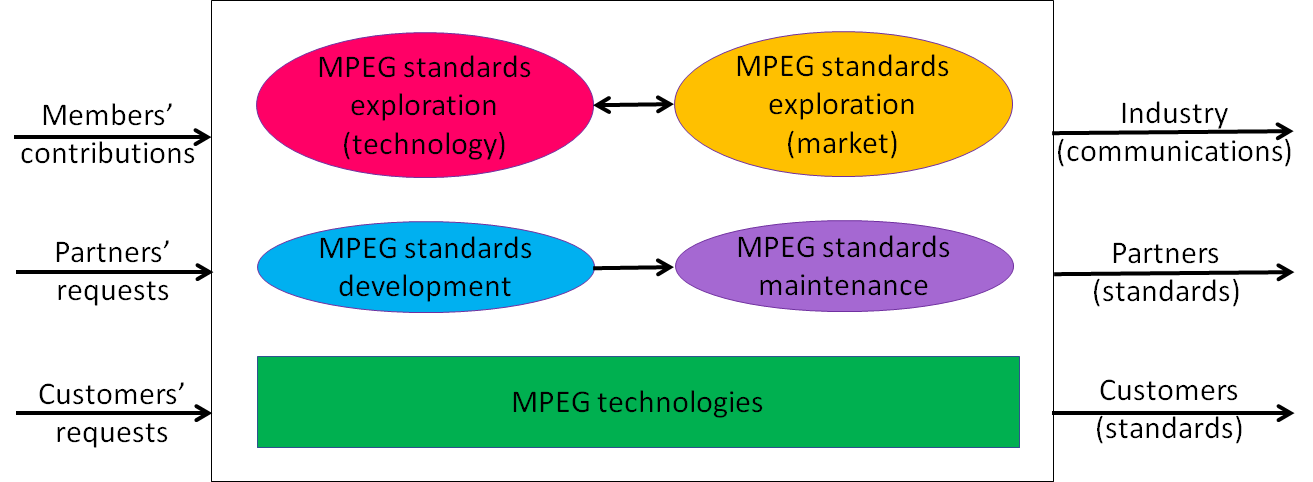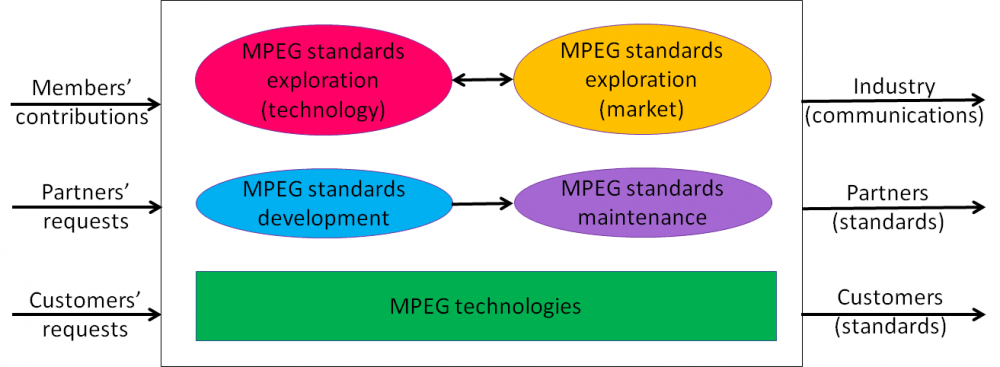Introduction
Having become the enabler of a market of devices and services worth 1.5 T$ p.a., MPEG is a big achievement, but is that a climax or the starting point aiming at new highs?
This is a natural question to ask for a group that calls itself “MPEG Future”. The future is still to be written and the success of MPEG will largely depend on the ability of those who attempt to write it.
This article will try and analyse the elements of an answer though the following steps:
- The MPEG machine as it has been running for several years
- The key success factors
- The situation today
- What’s next to make MPEG bigger.
The MPEG machine: input, processing and output
To understand if MPEG can be bigger the first thing to do is to understand how could MPEG reach this point. I will start doing that by considering a simplified model of the MPEG standards ecosystem that I believe is what has made MPEG the big thing that we know (Figure 1.

Figure 1: The current MPEG standard ecosystem
The MPEG machine has three iterative phases of operation
- MPEG receives inputs from 3 sources:
- MPEG members
- Partners, i.e. committees who may be interested in developing a joint standard
- Customers, typically committees or industry associations who may need a standard in an area for which MPEG has expertise.
- MPEG processes inputs and may decide
- To start an exploration by studying use cases and requirements, or by exploring technologies
- To develop a new MPEG standard, if the exploration is successful
- To extend or correct an existing standard.
- MPEG generates outputs
- To the industry at large, by announcing its work plan, milestones of the work plan such as Calls for Proposal, events such as workshops, results of verification tests etc.
- To communicate to partners and customers about how MPEG is handling their inputs or to seek their opinion or to propose new initiatives
- To inform partners and customers of the progress of its standard and eventually making standards available.
MPEG’s key success factors
These are the main success factors of MPEG’s handling of the business of standardisation.
- Search for customers. MPEG started with the vision of “digital media standards for a global market” but it did not have – and still does not have – a “constituency” whose interest it was expected to further. It assembled the expertise required to implement its vision, but needed to find buyers for its standards. Finding customers is the main element of MPEG’s DNA.
- Customer care. Each industry has its own requirements, some shared with others. MPEG needed to find both the common denominator of requirements and the industry-specific requirements, and to design solutions where all industries could operate unencumbered by the requirements of others.
- Integrated standards. MPEG has been able to develop complete digital media solutions without leaving its customers struggling with the task of making different pieces from different sources work together. Still the single parts can be individually used.
- The role of research. MPEG has been a magnet attracting the best researchers in digital media from both industry and academia and is influencing many research programs.
- New customers without losing old ones. With MPEG-2, MPEG had “acquired” the broadcasting industry, but with MPEG-4 it acquired the IT and mobile industry. MPEG succeeded in providing the same standards to both industries even though they were more and more in competition. This has continued in other areas of MPEG standardisation.
- Strategic plans. MPEG has developed its program of work through collaboration with its client industries. MPEG does not have a centralised “strategic planning” function, but this function is part of its modus operandi.
- Business model. Companies participating in MPEG know that good technologies are rewarded by royalties and that they should invest in technologies for future standards.
The situation today
The MPEG operation has seen many years of successes, but the context has greatly changed.
- MPEG has an impressive portfolio of standards actively used by a global number of loyal customers.
- The media industry has greatly expanded in scope and its members are becoming more diverse.
- MPEG values the requirements of its customers but there are so many technologies fighting for dominance
- There is an increasing percentage of MPEG members who come from research/academia or are NPEs
- Acquiring new customers in new areas is getting more and more onerous
- Many work items in the strategic plan heavily depend on technologies whose development path is unclear
- The MPEG business model is still an asset, but may no longer serve the needs of a significant part of MPEG customers.
And now, what?
MPEG Future strives to facilitate the creation of a new environment that will enable the development of standards for media compression and distribution and their adoption for ever more pervasive media-related user experiences.
What should be the principal axes of the new MPEG age advocated by MPEG Future?
Technology? Sure, mastering technology for top performing standards remains important to MPEG, but commonality and synergies of technologies is not the issue. MPEG has a large and dedicated group of experts who explore the implications of new technologies (more is better, but it is not the issue).
Market? Sure, market is important. Companies may be reluctant to talk too much about market but making standards that are driven by research and academia is not the way to go.
The principal axis of the next phase of MPEG work should focus on how market players want to package technologies – that MPEG Future obviously advocates to be standard – to serve market needs.
MPEG Future envisages that a new group called Market Needs be created in MPEG in its new status of subcommittee, next to the existing Technical Requirements group. The latter should continue to explore the technology side of new ideas, while the former should monitor the relevance of new ideas as enabled by technology, to market reality. The new form of the MPEG standards ecosystem is depicted in Figure 2.

Figure 2: The neW MPEG standard ecosystem
There are two main challenges for the new MPEG standards ecosystem
- A Market Needs group populated with industry leaders
- A modus operandi where inputs from Market Needs to Technical Requirements enrich the technical exploration and results from Technical Requirements to Market Needs are used to strengthen the market value of the a new idea.
MPEG is well placed to create an effective Market Needs group because of its network of partners and customers and is well placed to extend its modus operandi with an effective Market Needs – Technical Requirements interaction. After all MPEG has spent its last 30 years incorporating new communities. The Market Needs community is of a new type, but this makes the challenge all the more enticing…
Posts in this thread
- MPEG is a big thing. Can it be bigger?
- MPEG: vision, execution,, results and a conclusion
- Who “decides” in MPEG?
- What is the difference between an image and a video frame?
- MPEG and JPEG are grown up
- Standards and collaboration
- The talents, MPEG and the master
- Standards and business models
- On the convergence of Video and 3D Graphics
- Developing standards while preparing the future
- No one is perfect, but some are more accomplished than others
- Einige Gespenster gehen um in der Welt – die Gespenster der Zauberlehrlinge
- Does success breed success?
- Dot the i’s and cross the t’s
- The MPEG frontier
- Tranquil 7+ days of hard work
- Hamlet in Gothenburg: one or two ad hoc groups?
- The Mule, Foundation and MPEG
- Can we improve MPEG standards’ success rate?
- Which future for MPEG?
- Why MPEG is part of ISO/IEC
- The discontinuity of digital technologies
- The impact of MPEG standards
- Still more to say about MPEG standards
- The MPEG work plan (March 2019)
- MPEG and ISO
- Data compression in MPEG
- More video with more features
- Matching technology supply with demand
- What would MPEG be without Systems?
- MPEG: what it did, is doing, will do
- The MPEG drive to immersive visual experiences
- There is more to say about MPEG standards
- Moving intelligence around
- More standards – more successes – more failures
- Thirty years of audio coding and counting
- Is there a logic in MPEG standards?
- Forty years of video coding and counting
- The MPEG ecosystem
- Why is MPEG successful?
- MPEG can also be green
- The life of an MPEG standard
- Genome is digital, and can be compressed
- Compression standards and quality go hand in hand
- Digging deeper in the MPEG work
- MPEG communicates
- How does MPEG actually work?
- Life inside MPEG
- Data Compression Technologies – A FAQ
- It worked twice and will work again
- Compression standards for the data industries
- 30 years of MPEG, and counting?
- The MPEG machine is ready to start (again)
- IP counting or revenue counting?
- Business model based ISO/IEC standards
- Can MPEG overcome its Video “crisis”?
- A crisis, the causes and a solution
- Compression – the technology for the digital age


